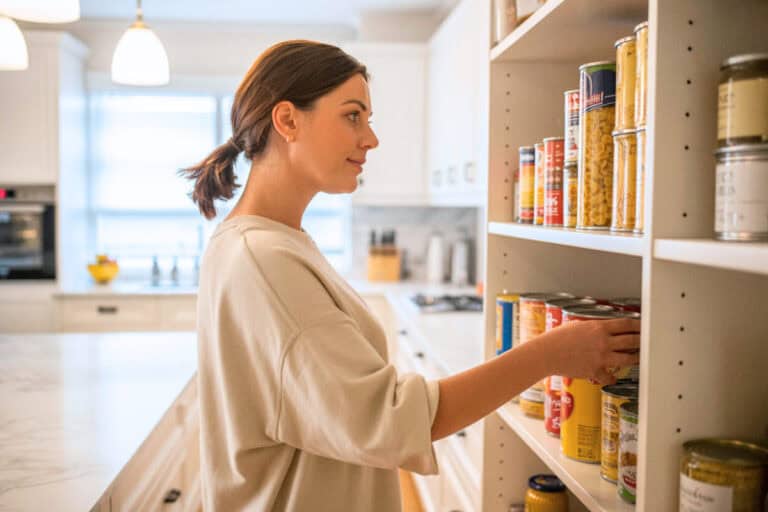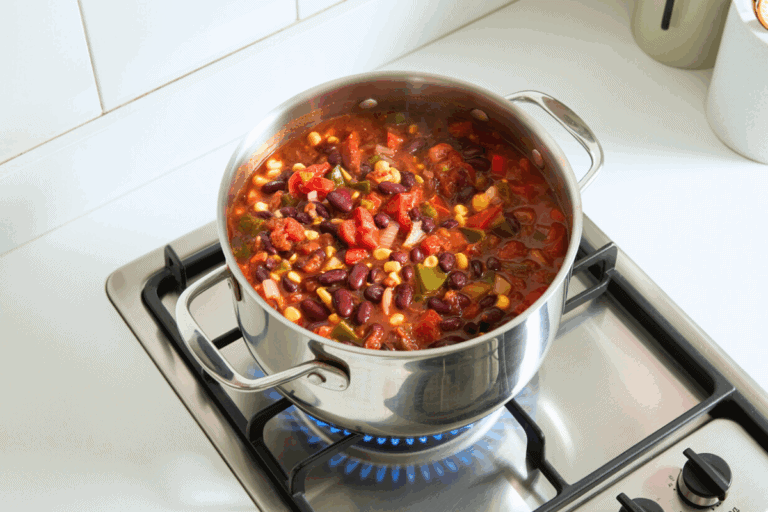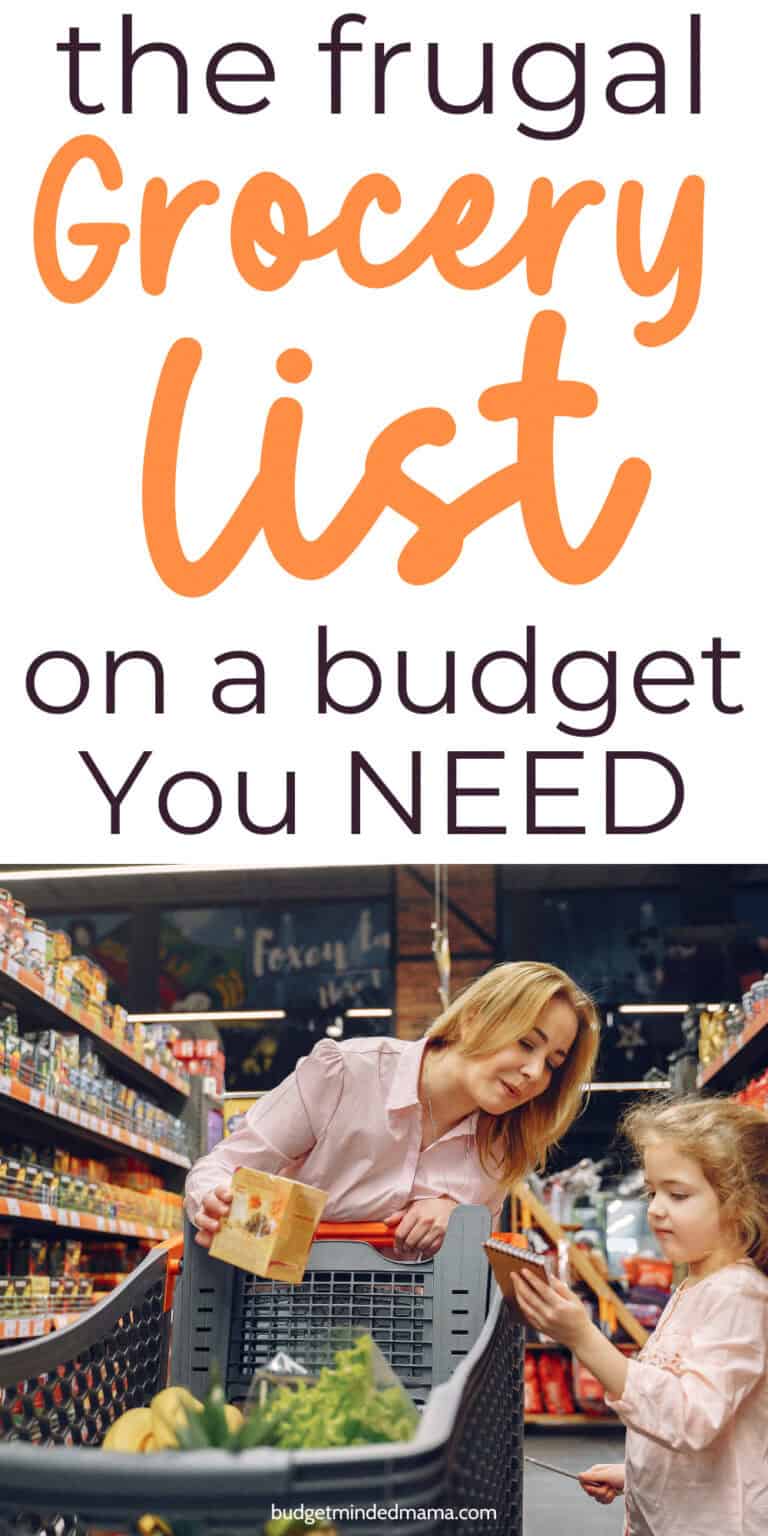Are your grocery bills creeping up every week no matter how hard you try to save?

I know exactly how that feels.
Every time I’d check out at the store, the total seemed higher than the week before — even when I was trying to be careful.
Living on one income means every dollar has a job, and when the grocery budget started taking over everything else, I knew something had to give.
Between rising prices, growing kids, and budget meal planning, it’s easy to overspend without realizing it.
One extra snack here, a few convenience items there — it adds up fast.
Before I knew it, I was spending hundreds more each month than I planned, and it was stressing me out every time I opened my bank app.
The good news is, you don’t have to keep feeling that pinch.
Once I started tracking what we actually bought and making small changes to how I planned our meals, I was able to save over $200 a month with a grocery list budget and it didn’t mean cutting out the food my family loves.
Now, grocery shopping feels less overwhelming and a lot more intentional. I can walk into the store with a plan, fill my cart with what we actually need, and still stick to our budget.
Here’s exactly how I cut our grocery bill without giving up our favorite meals or the comfort of family dinners.
The Grocery List Budget that Saved Me $200/Month Feeding a Large Family

Feeding a large family on one income can feel impossible some weeks. No matter how hard you try to stick to your budget, the cart fills up fast and the total always seems higher than expected.
What finally helped was creating a simple grocery list that focused on affordable staples, and that one change saved me over $200 every single month.
1. Track What You’re Actually Spending
Before you can start saving, you have to see exactly where your money is going, and sometimes that part stings a little.
When I first sat down with my receipts, I realized how quickly “small” purchases added up.
A few coffee runs here, a drive-thru night after practice, and those “just one thing” grocery trips were quietly draining hundreds from our monthly budget.
If you haven’t done it yet, take a few minutes to go through your last two or three months of spending.
Write down every grocery run, takeout order, and snack stop.
You might be surprised at how much of your money isn’t actually going toward full meals.
Once you see the full picture, it’s easier to make better choices.
You’ll start to notice patterns like maybe weekends are when you overspend, or maybe certain stores tempt you into grabbing extras.
Knowing this helps you plan smarter for next month.
Pro tip: Download the free Fetch Rewards app and start scanning every receipt — even for gas or restaurants. You’ll earn points that can be redeemed for gift cards to places like Target or Amazon. I’ve been using it for months, and it feels good knowing those little slips of paper are finally paying me back instead of reminding me what I overspent.
2. Meal Plan Around What You Already Have
Before I started meal planning the right way, I’d scroll through recipes online and write down whatever looked good.
The problem?
I’d end up buying tons of new ingredients when half of what I needed was already sitting in my pantry.
It wasn’t just wasting food , it was wasting money, too.
Now, I start every week by taking a quick look at what we already have in the fridge, freezer, and cupboards.
If there’s half a bag of rice, a few cans of beans, and some frozen chicken, that’s at least two dinners right there.
You’d be surprised how many meals you can make just by combining what’s already on hand.
Here’s what I do each week:
- Take quick inventory of what’s in the house.
- Pick 4–5 meals using what I already have.
- Only write down the missing ingredients I truly need to buy.
This one small shift has made a huge difference. Not only do I save $40–$50 a week, but I waste less food and spend less time wondering what to make for dinner.
When I plan “stretch meals” — dinners like tacos, chili, or stir fry that easily last two nights — I stretch both the food and my budget even further.
It’s such a simple system, but it’s been one of the biggest game changers for saving money on groceries.
3. Shop at Home First

Take a few minutes to “shop” your own kitchen first before you go grocery shopping.
I started doing this when I realized how often I was buying duplicates of things we already had — like extra pasta, canned goods, or snacks hiding in the back of the cupboard.
Those little repeats might not seem like much, but they add up fast.
Now I set a timer for 10 minutes and do a quick kitchen sweep.
I check the pantry, fridge, and freezer to see what I can use up before buying anything new.
It’s actually kind of fun because I end up creating meals I never planned — like burrito bowls with leftover rice, beans, and frozen veggies, or breakfast-for-dinner nights when I find extra eggs and bread.
A little organization goes a long way here too.
I keep a small dry-erase board on the fridge where I jot down what’s running low or needs to be used soon.
It keeps me from double-buying and helps me remember what we already have.
Once you get into this habit, you’ll notice fewer wasted ingredients, fewer random grocery runs, and way more savings at the end of the month.
4. Set a Weekly Grocery Budget
One of the biggest mistakes I made in the beginning was telling myself, “I’ll just try to spend less this week.”
But without a real number to stick to, it never worked.
I’d head to the store, grab a few extras here and there, and by the end of the week, I’d already gone over budget without even realizing it.
Now, I set a clear weekly grocery limit, for our family, that’s $125 per week.
It covers everything: meals, snacks, and household basics.
Once that money is gone, that’s it.
No midweek runs, no “just one more trip” for milk or snacks that always turns into $40 of extras.
Sticking to this rule helped me stop overspending and forced me to get creative with what we already had at home.
Some weeks, I’ll pull the amount in cash and use the envelope system because it’s easier to see exactly what’s left.
Other times, I’ll track it with a budget app.
Either way, the point is to stay accountable.
When you have a set number, grocery shopping becomes more intentional.
You’ll start planning better, wasting less, and feeling way more in control of where your money is going.
If you don’t have a grocery budget yet, set one today — even if it’s small at first.
It’s one of the easiest and most effective ways to get your spending under control and finally stop wondering where all your money went.
5. Scan Your Recipts
This tip might sound small, but it’s one of those habits that truly pays off.
Every time you shop — whether it’s for groceries, gas, or even takeout — make it a habit to scan your receipts.
I used to throw mine away without a second thought, but once I realized those little pieces of paper could actually earn me rewards, I never stopped.
Apps like Fetch and Ibotta are game changers.
With Fetch, you simply snap a photo of your receipt, and you instantly earn points that can be redeemed for gift cards to places like Target, Amazon, or Starbucks.
Ibotta works similarly but gives you cashback for specific items you purchase.
Between the two, I’ve earned hundreds over time, just for doing what I was already doing.
The best part?
It takes less than a minute, and you don’t have to change how you shop. You’re literally turning your everyday purchases into money back in your pocket.
So before you toss your receipts, take a quick photo. It’s such an easy win, and those points add up faster than you’d expect, especially when you’re already working hard to stay on budget.
6. Buy Generic and Check the Markdowns
For the longest time, I stuck to name brands because I assumed they were better quality.
But when we started cutting back and I actually compared ingredients and taste, I realized most store brands are nearly identical, just with a different label and a smaller price tag.
The difference at checkout? Huge.
Now, I automatically reach for generics when I’m shopping.
Things like pasta, cheese, canned goods, and snacks are usually the same quality but cost anywhere from 20% to 40% less.
For a family on one income, those small savings add up fast, especially when you’re buying multiple items every week.
I also make it a point to check the markdown or clearance section every time I shop.
Most stores quietly mark down items that are close to their sell-by date or have damaged packaging, but they’re perfectly fine to use.
I’ve scored bread for half price, bags of apples for a few dollars, and even pantry staples like rice and flour on sale.
By swapping brand loyalty for smart shopping, I easily save an extra $20–$30 each week without sacrificing quality.
It’s one of those small mindset shifts that doesn’t feel like a big change but makes a huge difference when you add it up over the month.
7. Go Meatless Once a Week

Meat prices have gone up so much that it’s often the biggest expense in the grocery cart.
When I realized how much of our weekly budget went just toward chicken and beef, I decided to try something new, one meatless night each week.
I’ll be honest, I wasn’t sure how my family would feel about it at first, but it turned out to be one of the easiest ways to save money without anyone noticing a big difference.
Now, it’s become part of our routine.
I plan one or two dinners each week that skip the meat but are still hearty and satisfying.
Some of our go-tos are:
- chili loaded with beans and veggies
- pasta with homemade vegetable sauce
- fried rice with eggs
- classic grilled cheese with tomato soup night
These meals cost a fraction of what a meat-heavy dinner would and still keep everyone full and happy.
You can even take it a step further by using up whatever vegetables or pantry staples you already have.
Toss leftover rice with frozen veggies for a quick stir fry or make a big batch of lentil soup for lunch the next day.
Cutting out meat just once a week can save $10–$20 easily — that’s up to $80 a month — and it’s a simple way to stretch your grocery budget without feeling deprived.
8. Stick to Your Grocery List
This one sounds almost too simple, but it’s where I used to fail every single week.
I’d head to the store without a plan, or worse — we’d go hungry.
The moment I started “just browsing,” I’d end up tossing random snacks, drinks, or new products into the cart, telling myself I’d use them later.
Spoiler: I usually didn’t.
Those impulse buys easily added $20–$40 every trip, and that extra spending was quietly wrecking my budget.
Now, I never step into the store without a list.
I plan my meals for the week, write down exactly what we need, and make it my rule to only buy what’s on that paper.
It takes away the guesswork and helps me stay focused, especially when the aisles are full of tempting deals or seasonal displays calling my name.
If you want to make it even easier, print out a grocery list template or use a free app to organize your items by section — produce, dairy, pantry, and so on.
It helps you move quickly through the store and avoid wandering.
Once you get used to sticking to your list, you’ll notice how much lighter your total is at checkout, and how much less food goes to waste during the week.
9. Skip Midweek Store Trips
This tip might be the biggest game-changer of all.
I used to tell myself, “I’m just running in for milk,” but somehow I’d always leave with a cart full of extras — chips, drinks, a new snack for the kids, maybe even a dessert I didn’t plan for.
Those quick midweek trips were costing us an extra $30–$50 each time, and I didn’t even realize it until I started tracking our spending.
Now, I plan for one main grocery trip each week and make it count.
Before I go, I double-check what we’re low on — things like milk, bread, eggs, and snacks — so I don’t have to go back midweek.
If we run out of something before the next trip, I get creative with what we have instead of rushing to the store.
It’s amazing how resourceful you can get when you make it a rule not to go back.
Having a few backup options helps, too.
I always keep a freezer stash of essentials like frozen veggies, extra meat, and bread, and I plan a “clean out the fridge” night once a week.
It’s our night to use up leftovers, finish small portions, and clear space for the next grocery run.
Not only does it save money, but it also cuts down on food waste — and those skipped midweek trips have easily saved us hundreds over the months.



